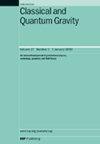Design and development of a prototype single crystalline silicon cryogenic suspension for 3rd generation gravitational wave detectors
IF 3.7
3区 物理与天体物理
Q2 ASTRONOMY & ASTROPHYSICS
引用次数: 0
Abstract
Current generation gravitational wave detectors rely on ultra-high purity fused silica in the final monolithic stage of the mirror suspension systems for their excellent thermal noise performance. There is however a push to develop cryogenic suspension systems for the next generation detectors, where fused silica loses its superior thermal noise properties. Silicon is an attractive candidate material, and is the baseline design selected for use in the cryogenic Einstein Telescope and brings with it a new set of challenges. This paper outlines what the authors believe to be the world’s first demonstration of a single ribbon hydroxy-catalysis bonded silicon suspension that has cycled between room temperature and a 4 K environment. Also discussed is the characterisation of similar silicon ribbon, detailing work on surface treatments used to improve the ultimate tensile strength alongside the thermal conductivity of the silicon suspension.第三代引力波探测器用单晶硅低温悬浮液的设计与研制
当前一代引力波探测器依赖于镜面悬挂系统的最后一个单片阶段的超高纯度熔融二氧化硅,因为它们具有出色的热噪声性能。然而,有一种推动下一代探测器的低温悬浮系统的发展,熔融二氧化硅失去了其优越的热噪声特性。硅是一种极具吸引力的候选材料,作为爱因斯坦低温望远镜的基准设计,它也带来了一系列新的挑战。这篇论文概述了作者认为是世界上第一个在室温和4 K环境之间循环的单带羟基催化键合硅悬浮液的演示。还讨论了类似硅带的特性,详细介绍了用于提高硅悬浮液的极限拉伸强度和导热性的表面处理工作。
本文章由计算机程序翻译,如有差异,请以英文原文为准。
求助全文
约1分钟内获得全文
求助全文
来源期刊

Classical and Quantum Gravity
物理-天文与天体物理
CiteScore
7.00
自引率
8.60%
发文量
301
审稿时长
2-4 weeks
期刊介绍:
Classical and Quantum Gravity is an established journal for physicists, mathematicians and cosmologists in the fields of gravitation and the theory of spacetime. The journal is now the acknowledged world leader in classical relativity and all areas of quantum gravity.
 求助内容:
求助内容: 应助结果提醒方式:
应助结果提醒方式:


